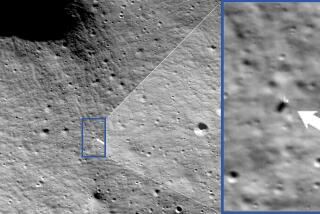Shuttle Poised for Satellite Rescue Today : Space: Endeavour should overtake orbiting target by mid-afternoon. Crew will then attempt to lasso and relaunch device.
- Share via
HOUSTON — The nation’s newest space shuttle, Endeavour, on Saturday streaked toward an unprecedented attempt to rescue a stranded communications satellite today by attaching it to a new rocket motor designed to propel it into a higher orbit.
As Endeavour entered its third day in space, the seven-member crew made detailed preparations to retrieve the $150-million satellite, which was left in a useless low-Earth orbit in March, 1990, when the commercial Titan rocket that launched it malfunctioned.
Engineers for the communications consortium that owns the satellite, International Telecommunications Satellite Organization, have been directing the device toward its rendezvous position by activating thrusters on the satellite that dropped it from a 350-mile-high orbit to an orbit 225 miles above the Earth.
By Saturday evening, the shuttle was trailing the Intelsat 6 satellite by 975 miles, and was closing at a rate of 86 miles each orbit.
“It’s (been) a nice quiet day, building up to the extremely ambitious day we have (Sunday),” Al Pennington, flight director for the National Aeronautics and Space Administation, said during a briefing at the Johnson Space Center. The spacecraft lifted off Thursday evening from the Kennedy Space Center in Florida.
If all goes as planned, the rescue will begin at 1:30 p.m. PDT today as Endeavour enters its 48th orbit and astronaut Pierre J. Thuot, 36, a U.S. Navy commander, enters the shuttle’s cargo bay.
Thuot will begin by tethering his feet to the shuttle’s movable arm. Inside the orbiter, astronaut Bruce E. Melnick, 42, a Coast Guard commander, will guide the arm to lift Thuot within reach of the 12-foot wide Intelsat 6, which will be rotating at a rate of once every two minutes.
Thuot is to grab the 8,960-pound, 17-foot-tall satellite from the bottom with a specially designed “capture bar,” and then manually halt its rotation. He will then hook the bar to the shuttle arm and Melnick will guide Thuot and the satellite into the shuttle bay.
There, Thuot will work with astronaut Richard J. Hieb, 36, to hitch the satellite to the frame that houses a new 23,000-pound, solid-fuel rocket motor. After the two crew members attach electric umbilical cords linking the motor to the satellite, they will set four, pre-loaded springs that, minutes later, will push the satellite and reboost the rocket back into space.
Once the spacewalkers are safely inside, the crew will release the springs to send the satellite assembly spinning away from the shuttle at a speed of about a half-foot per second.
Intelsat controllers in Washington, D.C., are scheduled to fire the rocket motor Monday, initially propelling the satellite into an elliptical orbit reaching as far as 51,750 miles from the Earth. Eventually, the satellite is to settle into the lower orbit over the Atlantic Ocean, where it can relay telephone and television signals, including video of the 1992 Summer Olympics.
Intelsat is paying $93 million for the rescue mission. The cost of a shuttle mission has been pegged at between $250 million and $500 million, depending on the overhead, salary and development costs included in the calculation.
During two other scheduled spacewalks, on Monday and Tuesday, astronauts will practice techniques to be used on future missions to repair the flawed Hubble space telescope and to assemble the planned space station Freedom.
More to Read
Sign up for Essential California
The most important California stories and recommendations in your inbox every morning.
You may occasionally receive promotional content from the Los Angeles Times.










